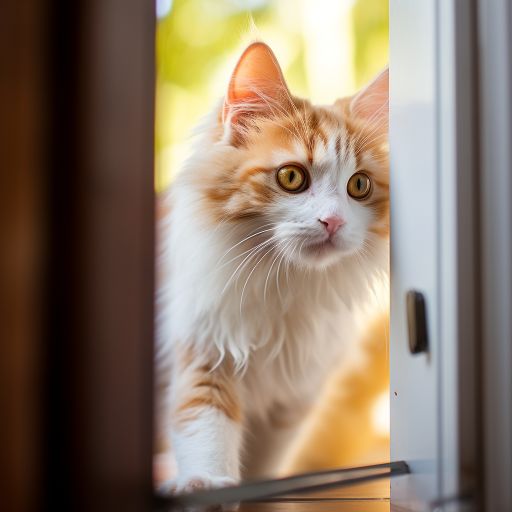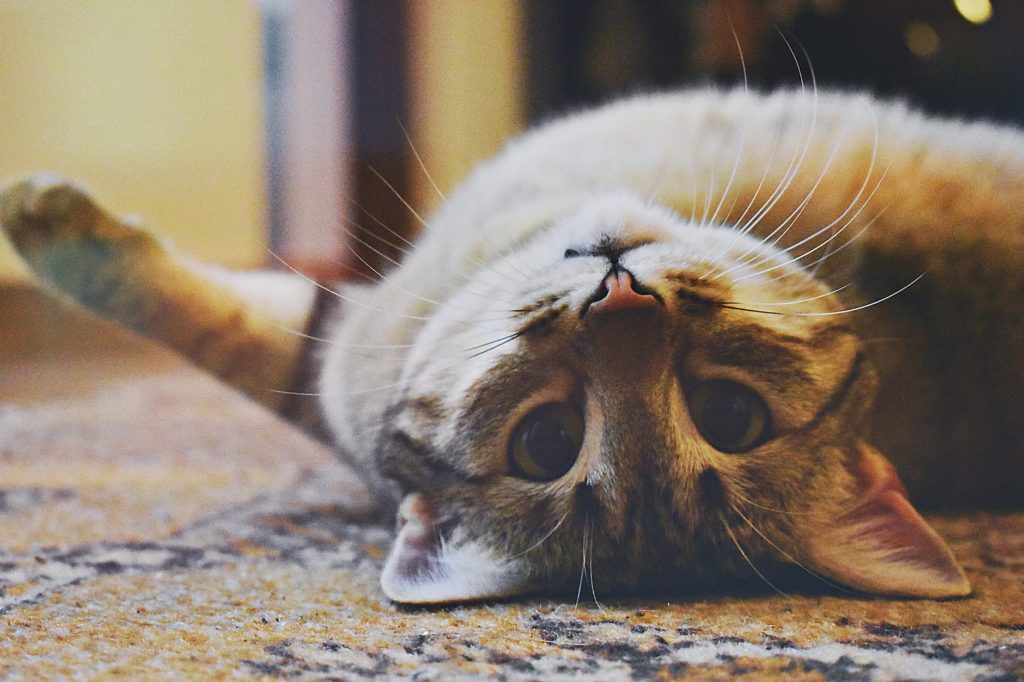Cat Behavior Problems
Cat behavior problems are a common issue that many pet owners face. Although cats are often seen as independent and low-maintenance pets, they can still experience a range of behavioral issues that can be frustrating for owners to deal with. However, with the right approach, many of these problems can be addressed and resolved.
At our SEO and copywriting agency, we’ve seen a significant increase in interest in this topic. As such, we’ve decided to share our expertise on the matter. In this article, we’ll outline some common cat behavior problems, and offer advice on what to do and what not to do to address them effectively.
Live Pee Free! Odor Eliminator 100% Eliminates Pet Odor on Contact. 20% Off. No Enzymes, No Fragrance, No Detergent, No Bleach – Safe for Kids and Pets.10 Proven Solutions to Cat Behavior Problems: Do’s and Don’ts of Feline Care
Table of Contents
Understanding Cat Behavior Problems
Cats are fascinating creatures, yet they can sometimes exhibit perplexing behavior. From scratching furniture to litter box aversions, these cat behavior problems can be puzzling for even the most devoted pet owners. Understanding these behaviors is crucial to addressing them effectively. Behavioral issues can stem from various sources, including stress, health problems, and environmental factors.
Before embarking on solutions, it’s essential to identify the underlying cause of the behavior. For instance, a cat that suddenly stops using its litter box may be experiencing a medical issue or a change in its environment. Recognizing and analyzing these nuances enables you to handle each situation appropriately. This blog post will delve into ten proven solutions to common cat behavior problems, outlining actionable do’s and don’ts that every cat owner should know.
1. Scratching Furniture: The Art of Feline Grooming
Cats naturally scratch surfaces to sharpen their claws, mark their territory, and stretch their muscles. However, this behavior often leads to frustration for cat owners who want to preserve their furniture. Cat Behavior Problems. Fortunately, there are effective strategies for mitigating this behavior without resorting to declawing, which is harmful and unnecessary.
Do: Invest in high-quality scratching posts. Cats love to scratch, so providing them with alternatives can redirect this behavior. Place scratching posts near the furniture your cat tends to target. Cat Behavior Problems. Experiment with different materials and sizes to find what your feline enjoys most. Consider using catnip to attract them to these designated areas.
Don’t: Use deterrents or sprays that can harm your cat or ruin your furniture. Avoid punishing your cat, as it can create fear and stress, exacerbating the problem. Cat Behavior Problems. Instead, focus on motivating your cat to use appropriate scratching surfaces and reward them when they do.
2. Litter Box Aversion: Navigating Bathroom Preferences
A cat’s litter box habits can be a major source of stress for owners. If your cat suddenly refuses to use the litter box, it might signal a behavioral or health issue. Cat Behavior Problems. Understanding a cat’s litter box preferences is vital for both your cat’s comfort and your household cleanliness.
Do: Maintain a clean litter box. Most cats require a clean space for their elimination needs. Scoop the litter daily and change it completely once a week. Cat Behavior Problems. Moreover, consider the type and texture of your litter, as some cats may have strong preferences. Experiment with different types—clay, clumping, or natural options—to see what your cat prefers.
Don’t: Avoid scolding your cat for accidents outside the box. This only increases anxiety and can lead to further issues. Cat Behavior Problems. Additionally, don’t place the litter box in a high-traffic or noisy area, as this might deter your cat from using it. A quiet, safe location is ideal for their comfort.
3. Excessive Meowing: Deciphering Your Cat’s Chatter
IShe repetitive vocalizations can drive cat owners to distraction. Cat Behavior Problems. While some breeds are naturally more vocal than others, excessive meowing can indicate underlying issues, from seeking attention to health concerns.
Do: Pay attention to the context of the meows. Determine if your cat is hungry, bored, or anxious. Providing interactive toys or engaging in playtime can help reduce excessive vocalizations. Sometimes, cats meow simply to get your attention, so rewarding silent moments with affection reinforces desired behavior.
Don’t: Ignore your cat’s vocalizations completely, as this can lead to frustration for both parties. If the excessive meowing persists, consult with a veterinarian to rule out any health issues. Understanding the reason behind the noise can greatly enhance your communication with your furry companion.
4. Aggression: Understanding Feline Combativeness
Aggression is one of the more alarming cat behavior problems and can arise from fear, territorial disputes, or redirected energy. Identifying the source of your cat’s aggression is critical; addressing the behavior requires a nuanced approach.
Do: Provide safe spaces for your cat. Cats may display aggressive behavior when they feel threatened. Cat Behavior Problems. Create vertical spaces, such as cat trees or shelves, to give them a sense of security. Cat Behavior Problems. If aggression manifests during play, use interactive toys to prevent accidental bites or scratches during roughhousing.
Don’t: Avoid physical punishment or escalating confrontations. Such actions only exacerbate fear and anxiety, leading to a more aggressive demeanor. Cat Behavior Problems. Instead, focus on calm and positive reinforcement techniques to teach your cat appropriate boundaries and reduce aggressive tendencies.
5. Boredom and Destructive Behavior: Engaging Your Feline
Cats are intelligent creatures that require mental stimulation to thrive. Cat Behavior Problems. When bored, they may resort to destructive behaviors like knocking over objects, chewing on furniture, or excessive grooming.
Do: Provide a stimulating environment. Invest in toys, puzzle feeders, and interactive play sessions to engage your cat’s mind. Cat Behavior Problems. Regularly rotate toys to keep their interest piqued and consider creating a play regimen that includes daily activities.
Don’t: Allow your cat to remain in a monotonous environment. Avoid assuming that cats will entertain themselves without appropriate stimulation. Cat Behavior Problems. An enriched environment can significantly impact their overall well-being and reduce destructive tendencies.
6. Fear and Anxiety: Calming an Overactive Mind
Cats can be incredibly sensitive creatures, and fear or anxiety can manifest in various behaviors, from hiding to inappropriate urination. Cat Behavior Problems. Managing their psychological health is crucial for a harmonious home.
Do: Identify triggers that prompt fearful responses. Provide a safe space where your cat can retreat when they feel overwhelmed. Cat Behavior Problems. Gradual desensitization to stimuli can also help. For instance, if your cat is frightened by loud noises, expose them to softer versions of these sounds in controlled settings, gradually increasing the volume over time.
Don’t: Force your cat into stressful situations. Cat Behavior Problems. Avoid yelling or scolding them for fearful reactions; instead, employ positive reinforcement methods to build their confidence. Understanding their limits and patiently aiding them in overcoming fears is paramount to fostering a secure environment.
7. Clinginess: Balancing Affection and Independence
While many cat owners cherish their pets’ affections, excessive clinginess can become overwhelming. Cat Behavior Problems. A cat’s need for attention can stem from various reasons, including boredom, anxiety, or changes in the household.
Do: Encourage independence by providing solo play opportunities. Invest in toys that allow your cat to entertain itself, or create interactive feeding puzzles to stimulate their mind. Schedule regular play sessions, but also set aside moments where your cat learns to enjoy its own company.
Don’t: Ignore your cat entirely to discourage clinginess. Cats thrive on regular interaction, so completely withdrawing attention will only increase their anxiety. Instead, balance playtime with moments of independence to help your cat understand that being alone can also be enjoyable.
8. Over-Grooming: Recognizing Stress and Skin Issues
Many cats exhibit grooming behavior as a means of self-soothing. However, excessive grooming can lead to skin problems and alopecia. This behavior often signals stress, anxiety, or even allergies.
Do: Monitor your cat’s grooming habits closely. If you notice bald patches or raw skin, consult a veterinarian promptly. Identifying underlying issues—like stress triggers or dietary concerns—allows you to implement effective strategies to diminish grooming behavior.
Don’t: Dismiss over-grooming as merely a quirky cat behavior. Prolonged grooming issues can indicate serious health problems. Engage with your cat to identify sources of anxiety, and create a calming environment through pheromone diffusers or soothing music.
9. PICA: Addressing Unusual Eating Habits
Pica, the consumption of non-food items, can be a perplexing and hazardous behavior in cats. While the cause can vary, it often stems from boredom, stress, or nutritional deficiencies.
Do: Monitor your cat’s environment carefully. Remove non-food items they may be tempted to eat, and provide alternative textures, such as cat grass or safe chew toys. Ensuring a balanced diet can also alleviate nutritional deficiencies that lead to pica.
Don’t: Ignore the behavior or assume it’s just a phase. Consuming non-food items can lead to serious health complications, including obstructions. If your cat engages in this behavior, consult with your veterinarian to explore potential underlying causes and solutions tailored to your pet’s needs.
10. The Importance of Routine: Establishing a Feline-Friendly Schedule
Cats thrive on routine, and inconsistency can lead to various behavioral issues. A predictable schedule helps your cat feel secure and reduces anxiety, allowing them to know when to expect food, playtime, and cuddles.
Do: Establish a daily routine for feeding, playtime, and grooming. Cats appreciate knowing what to expect, which can lessen anxiety and promote cooperation. Aim for regular feeding times and make mealtime enjoyable with interactive feeders or engaging treats.
Don’t: Deviate from established routines without reason. Sudden changes in feeding times or household dynamics can disrupt your cat’s sense of security. If you must change a routine, do so gradually to help your cat adjust with less stress.
The Cat Owner’s Journey (Addition)
Addressing cat behavior problems requires patience, observation, and understanding. Each feline is unique, and implementing these ten proven solutions tailored to your cat’s needs can vastly improve their behavior and, subsequently, your relationship with them. Remember that building a bond with your cat is a journey—one that thrives on empathy, compassion, and a readiness to learn.
By investing time and energy into resolving these issues, you will not only enhance your cat’s quality of life but also create a more harmonious living environment for both of you. As you navigate the intricate world of feline behavior, embrace the joys and challenges that come with being a dedicated cat owner. The results will be gratifying, creating a stronger, more peaceful connection between you and your cherished companion.
Aggression
Aggression is one of the most common behavior problems in cats. This can be exhibited in several different ways, such as biting, scratching, or hissing. There can be several reasons why a cat may exhibit aggression, including fear, stress, territorial behavior, and even medical issues.
What to do: If you notice that your cat is exhibiting aggressive behavior, it’s essential to seek veterinary advice. This is especially important if your cat’s aggression is sudden, severe, or unprovoked. If the aggression is due to stress, try to identify and remove the stressors from your cat’s environment. Provide your cat with plenty of mental and physical stimulation, such as toys and playtime.
What not to do: Never physically punish or hit your cat if it exhibits aggression. This will only exacerbate the issue and could lead to further aggression or fear. Avoid yelling or shouting at your cat, as this will only increase their anxiety and make the problem worse.
Urine Marking
Urine marking is a common behavior problem in cats, particularly in males that have not been neutered. This behavior involves the cat spraying urine on vertical surfaces, such as walls, furniture, or doors. This can be a frustrating problem for owners, as the odor can be difficult to remove, and the behavior can damage property.
What to do: If your cat is urine marking, it’s essential to first rule out any medical issues that could be causing the behavior. Neutering your male cat can often help to reduce or eliminate urine marking. Provide your cat with plenty of litter boxes in different locations throughout the house. Clean any soiled areas thoroughly with an enzymatic cleaner to remove the odor.
What not to do: Never punish your cat for urine marking, as this can exacerbate the problem and create fear or anxiety in your cat. Avoid using ammonia-based cleaners to clean up urine, as the smell can actually attract your cat back to the same spot.

Scratching
Scratching is a natural behavior for cats, as it helps to remove the outer layer of their claws, and also marks their territory. However, this behavior can be destructive, particularly if your cat is scratching furniture or other household items.
What to do: Provide your cat with plenty of scratching posts and pads in different locations throughout the house. Encourage your cat to use the scratching posts by placing treats or toys on them. Trim your cat’s claws regularly to reduce damage to furniture.
What not to do: Never physically punish your cat for scratching, as this will only create fear and anxiety. Avoid using spray bottles or other aversive training methods to discourage scratching, as this will only teach your cat to fear you.
Excessive meowing
Excessive meowing can be a challenging and often frustrating issue for cat owners, especially when it becomes a nightly ritual that disrupts sleep. A variety of factors can contribute to this behavior, each requiring a careful assessment. One common reason is hunger; sometimes, cats meow to signal that they’re ready for their next meal or are simply seeking attention for food. Another possibility is boredom.
Cats are intelligent and curious creatures that thrive on stimulation, and a lack of play or interaction can lead them to vocalize more in an attempt to engage their humans. Additionally, medical issues could be at play, particularly in older cats. Conditions such as hyperthyroidism, pain, or cognitive dysfunction syndrome can cause increased vocalization.
It’s essential for pet owners to observe their cats closely to identify any changes in behavior, eating, or litter box habits that might indicate an underlying health problem. Furthermore, environmental changes, such as a new pet or moving to a new home, can trigger excessive meowing as cats express their anxiety or discomfort. Understanding the root cause of this behavior is crucial, allowing owners to implement effective solutions that can help restore peace and quiet in the household.

Agitation during grooming
Cats are known for their grooming habits, but some cats may become agitated or aggressive during grooming sessions. If this is the case, it’s important to approach grooming gradually and positively. Start with short grooming sessions and gradually increase the length over time. Provide your cat with plenty of positive reinforcement, such as treats or playtime, to help them associate grooming with positive experiences.
Overall, addressing cat behavior problems requires patience, persistence, and a willingness to try different strategies. By understanding the underlying causes of your cat’s behavior and providing them with appropriate resources and positive reinforcement, you can help them overcome their behavior issues and strengthen your bond with them




